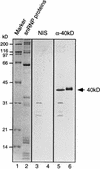The human U5-220kD protein (hPrp8) forms a stable RNA-free complex with several U5-specific proteins, including an RNA unwindase, a homologue of ribosomal elongation factor EF-2, and a novel WD-40 protein
- PMID: 9774689
- PMCID: PMC109259
- DOI: 10.1128/MCB.18.11.6756
The human U5-220kD protein (hPrp8) forms a stable RNA-free complex with several U5-specific proteins, including an RNA unwindase, a homologue of ribosomal elongation factor EF-2, and a novel WD-40 protein
Abstract
The human small nuclear ribonucleoprotein (snRNP) U5 is biochemically the most complex of the snRNP particles, containing not only the Sm core proteins but also 10 particle-specific proteins. Several of these proteins have sequence motifs which suggest that they participate in conformational changes of RNA and protein. Together, the specific proteins comprise 85% of the mass of the U5 snRNP particle. Therefore, protein-protein interactions should be highly important for both the architecture and the function of this particle. We investigated protein-protein interactions using both native and recombinant U5-specific proteins. Native U5 proteins were obtained by dissociation of U5 snRNP particles with the chaotropic salt sodium thiocyanate. A stable, RNA-free complex containing the 116-kDa EF-2 homologue (116kD), the 200kD RNA unwindase, the 220kD protein, which is the orthologue of the yeast Prp8p protein, and the U5-40kD protein was detected by sedimentation analysis of the dissociated proteins. By cDNA cloning, we show that the 40kD protein is a novel WD-40 repeat protein and is thus likely to mediate regulated protein-protein interactions. Additional biochemical analyses demonstrated that the 220kD protein binds simultaneously to the 40- and the 116kD proteins and probably also to the 200kD protein. Since the 220kD protein is also known to contact both the pre-mRNA and the U5 snRNA, it is in a position to relay the functional state of the spliceosome to the other proteins in the complex and thus modulate their activity.
Figures








References
-
- Abramson R D, Dever T E, Merrick W C. Biochemical evidence supporting a mechanism for cap-independent and internal initiation of eukaryotic mRNA. J Biol Chem. 1988;263:6016–6019. - PubMed
-
- Altschul S F, Gish W, Miller W, Myers E W, Lipman D J. Basic local alignment search tool. J Mol Biol. 1990;215:403–410. - PubMed
-
- Asano K, Kinzy T G, Merrick W C, Hershey J W. Conservation and diversity of eukaryotic translation initiation factor eIF3. J Biol Chem. 1997;272:1101–1109. - PubMed
Publication types
MeSH terms
Substances
Associated data
- Actions
LinkOut - more resources
Full Text Sources
Molecular Biology Databases
